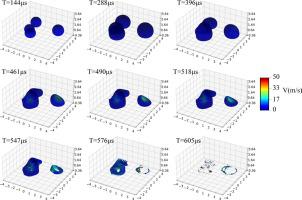International Journal of Pharmaceutics ( IF 5.3 ) Pub Date : 2021-09-08 , DOI: 10.1016/j.ijpharm.2021.121062 Yuchen Zhang 1 , Zhongwang Dou 1 , Jean-Christophe Veilleux 2 , Galen H Shi 2 , David S Collins 2 , Pavlos P Vlachos 1 , Sadegh Dabiri 1 , Arezoo M Ardekani 1

|
The collapse of cavitation bubbles induced by abrupt acceleration of the syringe in an autoinjector device can lead to protein aggregation. The details of bubble dynamics are investigated using an axisymmetric, three-dimensional simulation with passive tracers to illustrate the transport of protein molecules. When a bubble near the syringe wall collapses, protein molecules are concentrated in the re-entrant jet, pushed towards the syringe wall, and then spread across the wall, potentially leading to protein adsorption on the syringe wall and aggregation. This phenomenon is more prominent for bubbles positioned closer to the bottom wall, growing to a larger maximum radius. The bubble’s maximum radius decreases with the bubble’s distance from the syringe wall and air gap pressure, and increases with an increase in liquid column height and nucleus size. The strain rate induced by the bubble collapse is not large enough to unfold the proteins. When the re-entrant jet impacts the bubble surface or syringe wall, the bubble breaks up, generating smaller bubbles with high surface concentration of protein molecules, potentially inducing aggregation in the bulk. The bubble dynamics are influenced by dimensionless distance of the nucleus from the wall, normalized by maximum bubble radius (). The re-entrant jet velocity increases with , while the maximum liquid pressure, typically bar, first decreases and then increases with . For a cloud of cavitation bubbles, i.e., closely clustered bubbles, coalescence of bubbles can occur, leading to a higher peak pressure at collapse.
中文翻译:

模拟自动注射器中的空化气泡动力学及其对药物分子的影响
自动注射器装置中注射器的突然加速引起的空化气泡的破裂会导致蛋白质聚集。使用带有被动示踪剂的轴对称三维模拟来研究气泡动力学的细节,以说明蛋白质分子的运输。当注射器壁附近的气泡破裂时,蛋白质分子集中在折返射流中,被推向注射器壁,然后扩散到注射器壁上,可能导致注射器壁上的蛋白质吸附和聚集。对于靠近底壁的气泡,这种现象更为突出,并增长到更大的最大半径。气泡的最大半径随着气泡与注射器壁的距离和气隙压力而减小,并且随着液柱高度和核大小的增加而增加。气泡破裂引起的应变率不足以展开蛋白质。当折返射流撞击气泡表面或注射器壁时,气泡会破裂,产生具有高表面浓度蛋白质分子的较小气泡,可能会导致大量聚集。气泡动力学受核与壁的无量纲距离的影响,由最大气泡半径归一化()。再入射流速度随,而最大液体压力,通常 bar,先减少然后增加 . 对于空化气泡云,即紧密聚集的气泡,会发生气泡的合并,导致坍塌时的峰值压力更高。











































 京公网安备 11010802027423号
京公网安备 11010802027423号